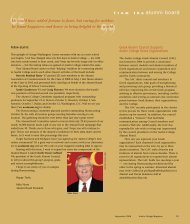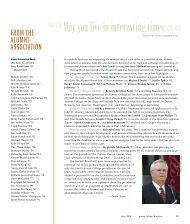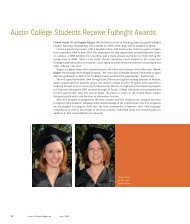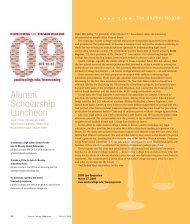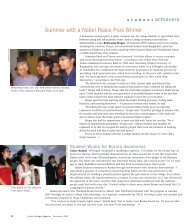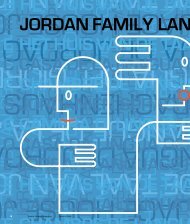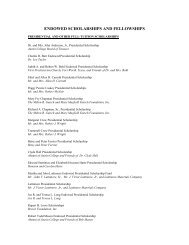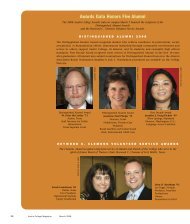view pdf format - Austin College Magazine
view pdf format - Austin College Magazine
view pdf format - Austin College Magazine
You also want an ePaper? Increase the reach of your titles
YUMPU automatically turns print PDFs into web optimized ePapers that Google loves.
Reaching a New Generation<br />
It was hard to miss students’ excitement on campus in the days leading up to and following<br />
Obama’s inauguration. Whether it was his own youth — at 47, Obama became the fifth youngest<br />
president ever elected — a fist-bumping image, or savvy use of new media, Obama connected with<br />
the nation’s young people, perhaps more effectively than any presidential candidate.<br />
The Obama team created a modern, technology “machine” that gave Obama a presence on<br />
myriad social networks; sent — and responded to — innumerable email and text messages (with a<br />
reported email database of 10 million); filmed videos, offered ringtones; posted thousands of hours<br />
of content on YouTube; and built BarackObama.com, with its MyBarackObama social network,<br />
which according to the Washington Post, signed on more than a million participants. This machine<br />
mobilized volunteers, solicited funds, and inspired millions. Content could be loaded onto cell<br />
phones, accessed online, and transmitted instantly.<br />
“For me in my busy day, the Internet was the fastest and most accessible way to stay posted on<br />
the candidates, the election process, and polls,” said Jeff Ridenour ’11. “I believe this campaign’s<br />
use of the Internet played a significant role in updating and keeping the youth of our nation<br />
involved and interested.”<br />
Rachel Mims ’11 noticed campaigning done through Facebook and MySpace — popular online<br />
social networking Web sites that she said most young people log into at least once a day. “The use<br />
of the Internet in the 2008 election was one of the best moves made in campaigning,” she said. “I’m<br />
one of those million young adults that found out more about the candidates through groups located<br />
on Facebook. This new use of the Internet has changed the way campaigning will be done forever.”<br />
Merritt O’Boyle ’11 said she used the Internet to share her <strong>view</strong>s and debate with others on<br />
political issues and candidates during the campaign. “The Internet is an incredibly effective way to<br />
reach out, especially to young adults,” she said. “I<br />
definitely used the Internet to get involved and let<br />
my voice be heard. The Internet played a big part,<br />
and I’m not sure Obama could’ve raised the<br />
volunteer power or funds he did without it.”<br />
More people gave to the Obama campaign than<br />
any campaign in history, according to ABC News<br />
reports. Team Obama estimated its total number of<br />
donors to be just shy of four million. According to<br />
the Center for Responsive Politics, the Obama<br />
campaign raised more than $650 million in<br />
individual donations (88 percent of his total<br />
campaign funds). Part of Obama’s success in<br />
reaching not only the individual vote, but also the<br />
individual pocketbook stems from his campaign’s<br />
ability to take the grassroots movement online.<br />
Editor’s Note: This article is not intended to make any political<br />
statement or endorsement, but to share students’ experiences as<br />
they participated in the historic culmination of the first<br />
presidential election in which most had participated.<br />
30 <strong>Austin</strong> <strong>College</strong> <strong>Magazine</strong> March 2009



